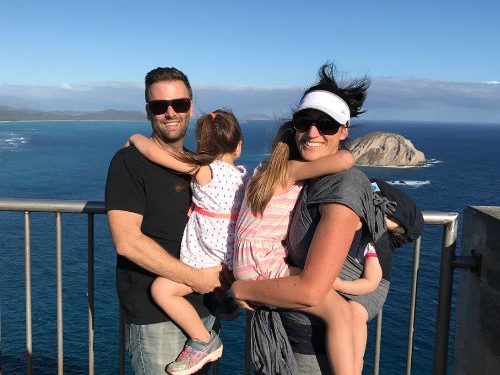[Updated] FAA cuts flights at 40 airports including Honolulu. Here’s what Hawaii travelers need to know ahead of holiday season

The Federal Aviation Administration (FAA) has announced unprecedented flight reductions affecting travel to and from Hawaii, creating widespread disruption for travelers planning trips to the islands. The cuts, which began on Friday, November 7, 2025, are a direct result of the ongoing government shutdown that has left thousands of air traffic controllers working without pay for over a month.
Related Podcast
Understanding the FAA Flight Cuts
On November 5, 2025, Transportation Secretary Sean Duffy announced the FAA would reduce flights by approximately 10% at 40 major U.S. airports due to severe staffing shortages among air traffic controllers. According to CNBC, this reduction affects 3,500 to 4,000 daily flights nationwide, impacting hundreds of thousands of passenger seats each day. The cuts represent one of the most significant disruptions to U.S. air travel in recent history.
Hawaii’s tourism-dependent economy faces particular vulnerability during this crisis. The state welcomes approximately 250,000 visitors per day during peak travel seasons, and any reduction in air service directly impacts not only tourists but also the local businesses, hotels, restaurants, and tour operators that depend on visitor spending.
Which Hawaii Airports Are Affected by the FAA Flight Cuts?
According to AP News, the FAA has released an official list of 40 airports where flight reductions will take effect. Honolulu International Airport (HNL) is the only Hawaii airport on the list, though travelers should note that major mainland gateway airports serving Hawaii are also heavily affected.
Major Gateway Airports Serving Hawaii:
West Coast Hubs:
- Los Angeles International Airport (LAX)
- San Francisco International Airport (SFO)
- Seattle/Tacoma International Airport (SEA)
- San Diego International Airport (SAN)
- Oakland International Airport (OAK)
- Portland International Airport (PDX)
Major U.S. Connection Points:
- Denver International Airport (DEN)
- Phoenix Sky Harbor International Airport (PHX)
- Dallas/Fort Worth International Airport (DFW)
- Dallas Love Field (DAL)
- Chicago O’Hare International Airport (ORD)
- Chicago Midway International Airport (MDW)
Other Affected Airports:
- Hartsfield-Jackson Atlanta International Airport (ATL)
- John F. Kennedy International Airport (JFK)
- Newark Liberty International Airport (EWR)
- LaGuardia Airport (LGA)
- Boston Logan International Airport (BOS)
- Miami International Airport (MIA)
- Orlando International Airport (MCO)
- Tampa International Airport (TPA)
- Fort Lauderdale/Hollywood International Airport (FLL)
The flight reductions began at 4% on Friday and are gradually ramping up to the full 10% reduction, where they will remain “until the FAA feels comfortable with safety levels,” according to sources cited by CNBC.
[Live Update] Real-Time Impact: First Hawaii Flight Cancellations Confirmed
As the FAA cuts moved from announcement to reality, Hawaiian Airlines became the first carrier to confirm specific Hawaii flight cancellations. On Thursday, November 6, 2025, the airline announced it would cancel four inter-island flights on Friday, November 7. These are the first actual disruptions to Hawaii’s air network since the government shutdown began.
Initial Cancellations Include:
- Two roundtrip flights between Honolulu and Maui
- Two roundtrip flights between Honolulu and Kona
Hawaiian Airlines still operates 20 daily roundtrips to Maui and 15 to Kona, with flights to Kauai and Hilo running as scheduled. The airline has confirmed that affected travelers will be rebooked or refunded.
Friday Morning Updates (7:10 a.m. HST):
By Friday morning, the cancellations spread beyond Hawaiian Airlines:
- Delta Air Lines cancelled its first Hawaii flight, the overnight service from Lihue to Seattle
- Southwest Airlines reported multiple inter-island cancellations at Honolulu and Kona
- Hawaiian Airlines cancelled additional inter-island flights beyond the initial four
Alaska Airlines, parent company of Hawaiian Airlines, issued a joint statement confirming both carriers will cancel “a limited number of flights” starting Friday. The company hasn’t specified which Alaska-operated Hawaii routes will be cut, but said most cancellations will happen on routes with multiple daily flights to allow same-day rebooking.
Hawaii DOT Takes Action:
Hawaii Department of Transportation Director Ed Sniffen formally requested that the FAA exempt Honolulu and other state airports from the planned 10% flight reduction. In a letter to U.S. Transportation Secretary Sean Duffy, Sniffen wrote that Hawaii is “uniquely vulnerable as the nation’s most isolated population center.”
Sniffen made an unusual offer: Hawaii would immediately fund the full salaries and benefits of all FAA air-traffic controllers and TSA screeners assigned to Hawaii facilities until the shutdown ends. The state DOT said it could implement this emergency measure within 24 hours to “maintain full flight schedules, protect public safety, and prevent unnecessary damage to a state that contributes disproportionately to America’s strategic interests.”
Why Inter-Island Cuts Matter:
Hawaii has no alternate rapid transportation between islands. When an inter-island flight cancels, travel plans stop. There’s no train, no bus, no ferry that can get you from Honolulu to Maui in a reasonable timeframe. For residents with medical appointments, business meetings, or family obligations, and for visitors with pre-booked activities and accommodations on multiple islands, these cancellations create serious problems.
Honolulu International Airport is the hub of Hawaii’s air network. Most inter-island connections flow through HNL. When Honolulu slows down, every neighbor island feels it within hours. Even small reductions at HNL affect the entire state.
The Government Shutdown Crisis
The root cause of these flight disruptions is the federal government shutdown, which as of November 6, 2025, has lasted 36 days, making it the longest government shutdown in U.S. history. Air traffic controllers, classified as essential personnel, have been required to continue working despite not receiving paychecks since October 1, 2025.
The prolonged shutdown has created unprecedented strain on the nation’s air traffic control system. Controllers are responsible for the safe and efficient movement of aircraft through U.S. airspace, and their work requires intense concentration and split-second decision-making. Working without pay for over a month has led to increased stress, fatigue, and staffing shortages as some controllers have called in sick or sought alternative employment.
Transportation Secretary Sean Duffy emphasized during a press conference that the cuts are a “proactive” measure. “We thought 10% was the right number based on the pressure we were seeing,” Duffy stated, adding that he expects more cancellations as a result of the reduction, which has no set end time.
FAA Administrator Bryan Bedford noted that additional measures could be implemented after the initial reduction. “As we slice the data more granularly, we are seeing pressures build in a way that we don’t feel, if we allow it to go unchecked, will allow us to continue to tell the public that we operate the safest airline system in the world,” Bedford said.
The FAA emphasized that the cuts are a proactive safety measure rather than a response to any specific incidents. By reducing the number of flights, air traffic controllers can manage their workload more effectively, reducing the risk of errors or accidents.
Airline Response and Passenger Policies
Major airlines serving Hawaii have responded to the FAA mandate by implementing flexible rebooking policies and waiving change fees for affected passengers. Here’s what each carrier is offering:
United Airlines CEO Scott Kirby announced in a memo to employees that the carrier will not be reducing long-haul international flying and hub-to-hub flying. Instead, United is reducing regional and domestic flights that do not fly between hubs. The airline is offering all customers refunds even if their flights are not impacted, including “non-refundable tickets and those customers with basic economy tickets.”
Delta Air Lines said it expects to operate the “vast majority” of its flights as scheduled, including all long-haul international service. Delta is offering changes, cancellations, or refunds for customers’ flights during the impacted period without penalty, including basic economy fares.
American Airlines stated that it expects the “vast majority of customers’ travel will proceed as planned.” The airline will proactively reach out to travelers as schedule changes occur and offer immediate rebooking options for all impacted travelers. Customers whose flights are canceled for any reason will be able to change their flight or request a refund without penalty.
Southwest Airlines released a statement saying that the majority of its flights will not be impacted and that its international flights should operate as usual. The airline said it will “proactively communicate well in advance and will offer flexibility in travel plans.”
Frontier Airlines CEO Barry Biffle offered practical advice on LinkedIn, recommending that travelers flying Friday or in the next 10 days book a backup ticket on another carrier to avoid getting stranded due to cancellations. “I’m sorry this is happening. Hopefully the shutdown is over soon,” Biffle wrote.
It’s important to note that airline policies may vary by route and ticket type. Travelers should contact their specific airline directly or check the carrier’s website for the most current information about their particular flight.
Essential Tips for Hawaii Travelers
Travel experts are calling this disruption comparable to the aftermath of 9/11 in terms of its impact on the aviation system. Nick Ewen, senior editorial director at The Points Guy, told CNBC that flexibility “is going to be key” as travelers rush to rebook.
Before Your Trip
- Download Airline Apps and Enable Notifications: Ewen recommends downloading each airline’s mobile app and enabling all notifications. “A lot of the times, you have to actually enable notifications on individual trips or in your account to text you if there are changes or disruptions,” he explained.
- Check Flight Status Multiple Times Daily: Airlines may adjust flights with as little as 24-48 hours notice. Monitor your flight status constantly in the days leading up to your departure.
- Consider Rescheduling Non-urgent Travel: If your trip to Hawaii is not time-sensitive, consider postponing until the government shutdown is resolved and flight schedules stabilize.
- Book Direct Flights When Possible: Flights with connections have a higher risk of disruption. If you can book a nonstop flight to Hawaii, you’ll reduce your chances of being stranded at a connecting airport.
- Consider Travel Insurance: Travel insurance can reimburse consumers for certain costs and inconveniences incurred from trip disruptions. However, experts warn that policies don’t offer blanket protection for shutdown-related travel issues. Cancel-for-any-reason coverage may provide the most flexibility, though it comes with its own caveats.
At the Airport
- Arrive Extra Early: AAA spokesperson Aixa Diaz recommends arriving at the airport extra early to avoid long lines. Plan to arrive at least 3 hours before domestic flights and 4 hours before international flights.
- Avoid Checking Bags: Diaz suggests avoiding checking in a bag if possible in case flights get canceled. Keep essentials in your carry-on, including medications, important documents, valuables, and a change of clothes.
- Use Self-Service Rebooking Tools: Be prepared for long wait times when contacting airlines. Use mobile apps and self-service rebooking tools when possible, as many other people will also be scrambling for limited seats.
- Practice Kindness: “The biggest thing is a lot of kindness goes a long way,” Ewen said. “If you’re at an airport and you find out that your flight is canceled, I promise you screaming at that airline employee is not going to get you rebooked any faster — in fact, it’s probably going to make them less likely to be willing to help you. So recognize that everyone is in this together.”
If Your Hawaii Flight Is Cancelled
- Contact Your Airline Immediately: Don’t wait in long airport lines. Call the airline’s customer service number, use their mobile app, or reach out via social media for faster rebooking.
- Ask About All Options: Inquire about alternative flights on partner airlines, different routes, or nearby airports that might get you to Hawaii sooner.
- Document Everything: Keep records of all communications with the airline, including confirmation numbers, agent names, and promises made.
- Understand Your Rights: While airlines aren’t required to compensate for delays caused by government actions, many are offering goodwill gestures. According to travel insurance experts, whether or not you get compensated may come down to the rationale an airline provides for a delayed or canceled flight.
Travel Insurance Considerations
Consumers have been buying travel insurance at an elevated rate amid the government shutdown, but travel and insurance experts warn that such policies don’t offer blanket protection for shutdown-related travel issues.
For example, a policyholder generally can’t get insurance benefits if they choose to cancel their travel plans to avoid any headaches. Cancel-for-any-reason coverage is an exception, though it also comes with its own caveats.
Whether or not a policyholder gets compensated may come down to the rationale an airline provides for a delayed or canceled flight. Many insurers only pay benefits if a delay or cancellation is attributable to a “common carrier” disruption like a mechanical failure.
“Airlines typically won’t cite causes other than operational terms like ‘mechanical issues’ or general delays, cancellations, or lost belongings, even during a government shutdown,” Lauren McCormick, a spokesperson for Squaremouth, an online platform for comparing travel insurance policies, wrote in a recent blog post. “So, these are generally still covered under most comprehensive travel insurance plans.”
Looking Ahead
The duration of these flight reductions remains uncertain and directly tied to the resolution of the government shutdown. Aviation industry experts warn that if the shutdown continues, the situation could worsen, with potentially deeper cuts to flight schedules.
The Association of Flight Attendants, representing 55,000 flight attendants at 20 airlines, released a statement urging Congress to end the shutdown so air traffic controllers and Transportation Security Administration workers can get paid. “The false narrative that this shutdown is a choice of either paying federal workers or protecting affordable healthcare is outrageous when both crises were manufactured by the exact people who can fix it,” the statement read.
Hawaii’s tourism industry is closely monitoring the situation, as extended flight reductions could have significant economic impacts on the state. Tourism accounts for approximately 21% of Hawaii’s economy, and any sustained decrease in visitor arrivals affects thousands of jobs across the islands.
Travelers planning trips to Hawaii in the coming weeks should remain flexible, stay informed about their flight status, and be prepared for potential changes. While the situation is challenging, airlines and airports are working diligently to minimize disruption and keep passengers moving safely.
For the latest updates on FAA flight cancellations affecting Hawaii, bookmark this page and check back regularly as the situation develops.
Sources:
RECOMMENDED POSTS
Ep. 181: 10 Best Local Restaurants on Oahu You Can’t Miss
Tired of overpriced resort food and generic chain restaurants in Waikiki? You're missing out on the real taste of Hawaii. The best local restaurants...
Ep. 180: What to Pack for Your Hawaii Vacation (Checklist Included)
Packing for Hawaii isn't just about tossing swimsuits and flip-flops into your suitcase. The wrong items—or forgotten essentials—can turn your dream...
Ep. 179: How to Beat the Post-Hawaii Blues: 3 Simple Steps to Keep the Aloha Alive
Ever stepped off the plane from Hawaii and felt like you just hit a wall? You're not alone. That post-Hawaii crash is real, and it affects millions...
Bryan Murphy, owner of Hawaii’s Best Travel, is a certified Hawaii destination expert from the Hawaii Visitors Bureau. He actively participates in the Hawaii Visitors and Convention Bureau as a member and has a strong educational background focused on local culture and sustainability. As the host of "Hawaii’s Best Travel," a top-30 US travel podcast, Bryan combines his years of experience with valuable insights. He connects with a broad online community, reaching nearly half a million people, and offers a richer, more responsible way to experience Hawaii.


![[Updated] FAA cuts flights at 40 airports including Honolulu. Here's what Hawaii travelers need to know ahead of holiday season 1 Ep. 181: 10 Best Local Restaurants on Oahu You Can’t Miss](https://hawaiisbesttravel.com/wp-content/uploads/2025/09/10-Best-Local-Restaurants-on-Oahu-You-Cant-Miss-400x250.jpg)
![[Updated] FAA cuts flights at 40 airports including Honolulu. Here's what Hawaii travelers need to know ahead of holiday season 2 Ep. 180: What to Pack for Your Hawaii Vacation (Checklist Included)](https://hawaiisbesttravel.com/wp-content/uploads/2025/09/What-to-Pack-for-Hawaii-400x250.jpg)
![[Updated] FAA cuts flights at 40 airports including Honolulu. Here's what Hawaii travelers need to know ahead of holiday season 3 Ep. 179: How to Beat the Post-Hawaii Blues: 3 Simple Steps to Keep the Aloha Alive](https://hawaiisbesttravel.com/wp-content/uploads/2025/09/How-to-Beat-the-Post-Hawaii-Blues-400x250.jpg)



